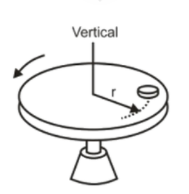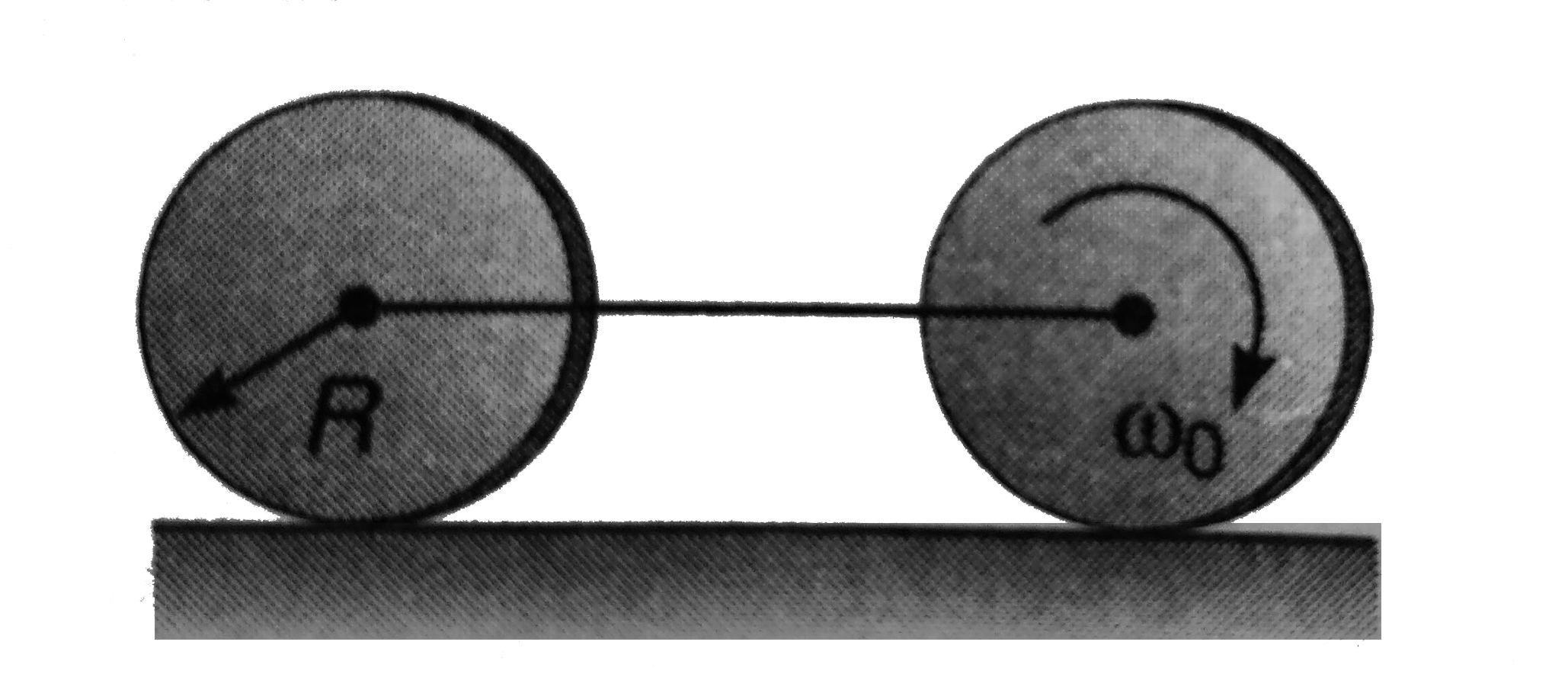A solid disc and a ring, both of radius 10 cm are placed on a horizontal table simultaneously, with initial angular speed equal to 10πrads−1. Which of the two will start to roll earlier ? The co-efficient of kinetic friction is μk=0.2.
Frictional force acting on the body,
f=μkR=μkmg………..(i)
where R(=mg) is the normal reaction of the table on the body. If a is the acceleration of the CM of the body
f=ma…………(ii)
From eqns. (i) and (ii)
ma=μkmg or a=μkg............(iii)
Torque due to frictional force i.e.,
τ==(μkmg)r=μkmgr
As τ=Iα.α=τI=μkmgr1
Linear velocity of CM of the body (initially at rest, v0=0) is given by
v=v0+at=at=μkgt.............(iv)
Angular velocity of the body after time t, i.e.
ω=ω0+αt=ω0−(μkmgrI)t...........(v)
(Here α has been taken negative as torque due to frictional force produces retardation)
v=rω...........(vi)
From eqs. (iv), (v) and (vi) we get
μkgt=r[ω0−μkmgrI]t=rω0−(μkmgr2I)t................(vii)
For a ring , as I=mr2, from eqn. (vii)
μkgt=rω0−(μkmgr2mr2)t=rω0−μkgt
or 2μkgt=rω0 or t=rω02μkg
or t=0.1×10π2×0.2×9.8=0.80s
(as r=0.1ω0=10πrad/s, μk=0.2, g=9.8m/s2)
or 3μkgt=rω0 or t=rω03μkg
or t=0.1×10π3×0.2×9.8=0.53s
Since t is less in case of disc the disc begin to roll earlier than the ring for the same values of r and ω0
Similar Questions
A solid disc and a ring, both of radius 10cm are placed on a horizontal table simultaneously, with initial angular speed equal to 10πrad/s. Which of the two will start to roll earlier ? The coefficient of kinetic friction is μk=0.2.
View SolutionA small coin of mass 40 g is placed on the horizontal surface of a rotating disc. The disc starts from rest and is given a constant angular acceleration α=2 rad s−2. The coefficient of static friction between the coin and the disc is μs=3/4 and the coefficient of kinetic friction is μk=0.5. The coin is placed at a distance r=1m from the centre of the disc. The magnitude of the resultant force on the coin exerted by the disc just before it starts slipping on the disc is?

View Solution
Knowledge Check
A ring of radius R is rotating with an angular speed ω0 about a horizontal axis. It is placed on a rough horizontal table. The coefficient of kinetic friction is μk. The time after it starts rolling is.
AωoμkR2gBωog2μkRC2ωoRμkgDωoR2μkg
A ring of radius 0.5 m and mass 10 kg is rotating about its diameter with angular velocity of 20rads−1. Its kinetic energy is
View SolutionA cylinder of mass 5kg and radius 10cm is moving on a horizontal surface with speed. 5m/s and angular speed about axis through C.M.10rad/s. Find the angular momentum of the cylinder about point of contact.
View SolutionA small coin of mass 80g is placed on the horizontal surface of a rotating disc. The disc starts from rest and is given a constant angular acceleration α=2rad/s2. The coefficient of static friction between the coin and the disc is μs=3/4 and cofficient of kinetic friction is μk=0.5. The coin is placed at a distance r=1m from the centre of the disc. The magnitude of the resultant force on the coin exerted by the disc just before it starts slipping on the disc is

View SolutionA small coin of mass 80g is placed on the horizontal surface of a rotating disc. The disc starts from rest and is given a constant angular acceleration α=2rad/s2. The coefficient of static friction between the coin and the disc is μs=3/4 and cofficient of kinetic friction is μk=0.5. The coin is placed at a distance r=1m from the centre of the disc. The magnitude of the resultant force on the coin exerted by the disc just before it starts slipping on the disc is

View SolutionA coin is placed at the edge of a horizontal disc rotating about a vertical axis through its axis with a uniform angular speed 2 rad s−1. The radius of the disc is 50 cm. Find the minimum coefficient of friction between disc and coin so that the coin does not slip. (Take g=10m/s2)
View Solution
The assembly of two discs as shown in figure is placed on a rough horizontal surface and the front disc is given an initial angular velocity ω0. Determine the final linear and angular velocity when both the discs start rolling. it is given that friction is sufficient to sustain rolling the rear wheel from the starting of motion.
View SolutionA disc of radius R=2m starts rotating wth constant angular acceleration α=(2rad)/s2. A block of mass m=2kg is kept at a distance R2 from the centre of disc. The coeffiecient of friction between disc and block is μs=0.4,μk=0.3. Acceleration of block when it just slips w.r.t. ground and w.r.t. disc are respectively−(g=10ms−2)
View Solution
